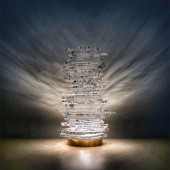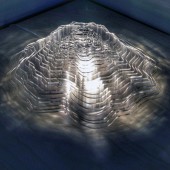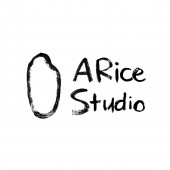Diatom Lights Illumination by Yingri Guan |
Home > Winners > #83458 |
 |
|
||||
| DESIGN DETAILS | |||||
| DESIGN NAME: Diatom Lights PRIMARY FUNCTION: Illumination INSPIRATION: This piece is inspired by the phenomenal contributions diatom algae bring to our world. Diatoms are light-absorbing molecules that convert light energy from the sun to chemical energy through photosynthesis. In the process, carbon dioxide are removed from the atmosphere, converted into sugar, and oxygen is released. In addition, diatoms are a major source of food for aquatic life on earth. Therefore, this piece aspires to celebrate diatoms as essential organisms to our whole ecosystem. UNIQUE PROPERTIES / PROJECT DESCRIPTION: Diatom involves generating a series of molecular outlines based on detailed analysis of diatom's geometric structure. The data is then transformed and abstracted to generative outlines through constructing a series of equations and formulas. Through algorithmic simulation and manipulation, the outlines are layered on top of each other based on diatom wall formations. The final visualization is in the form of light as diatoms convert light energy into chemical energy for other organisms' consumption. OPERATION / FLOW / INTERACTION: People can appreciate the beauty of this design through its presence in space. PROJECT DURATION AND LOCATION: This project was first initiated in October of 2018 in San Francisco, California. The final production was completed in February 2019. |
PRODUCTION / REALIZATION TECHNOLOGY: The layered outlines are first generated based on research data from diatom structures. The outlines are then transformed into three-dimensional structure based on diatom wall structure. The outlines are laser cut onto acrylic glass. Layers of cut acrylic glass are then algorithmically layered on top of each other to create the final physical light structure. SPECIFICATIONS / TECHNICAL PROPERTIES: Width 329mm x Depth 310mm x Height 196mm TAGS: algorithmic design, generative design, generative art, algorithm, coding, lighting, diatom, biological, ecosystem, design RESEARCH ABSTRACT: By collecting data such as the distance and angle between each wall structure, I then transform and abstract the data into generative outlines through constructing a series of equations and formulas. Through algorithmic simulation and manipulation, generative forms based on the data gathered and also equations constructed. The data are then entered into laser cut machines to produce different layers of cut shapes. Finally, different cut layers are then layered on top of each other based on algorithms. CHALLENGE: The most challenging part of the project is to how to transform all the data into a physical visualization. What kind of data use, as well as the equations that would be used to create the visualizations. ADDED DATE: 2019-03-08 07:43:55 TEAM MEMBERS (1) : Yingri Guan IMAGE CREDITS: Photographer (Yingri Guan / Designer) PATENTS/COPYRIGHTS: Copyrights belong to Yingri Guan, 2019. |
||||
| Visit the following page to learn more: http://yingriguan.com/ | |||||
| AWARD DETAILS | |
 |
Diatom Lights Illumination by Yingri Guan is Winner in Generative, Algorithmic, Parametric and AI-Assisted Design Category, 2018 - 2019.· Read the interview with designer Yingri Guan for design Diatom Lights here.· Press Members: Login or Register to request an exclusive interview with Yingri Guan. · Click here to register inorder to view the profile and other works by Yingri Guan. |
| SOCIAL |
| + Add to Likes / Favorites | Send to My Email | Comment | Testimonials | View Press-Release | Press Kit | Translations |
Did you like Yingri Guan's Generative Design?
You will most likely enjoy other award winning generative design as well.
Click here to view more Award Winning Generative Design.








